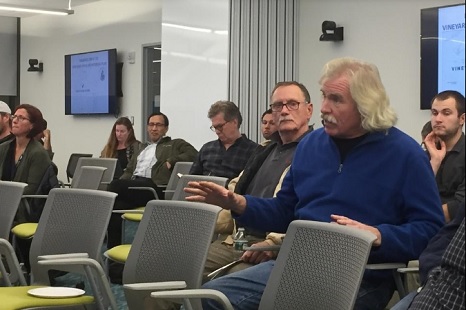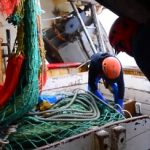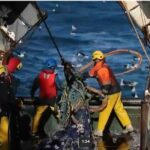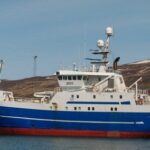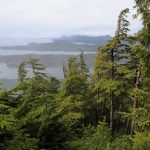Tag Archives: Kevin Stokesbury
SMAST’s Kevin Stokesbury: On scallops, community collaboration, and a lifelong love of the ocean
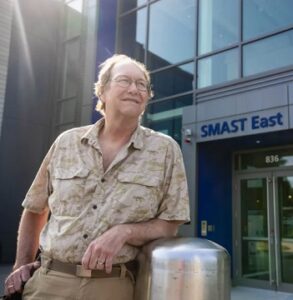 Growing up on the Bay of Fundy in Nova Scotia, Kevin Stokesbury spent as much time as possible swimming, searching for sand shrimp, and soaking up the sun with his siblings. Now as dean of the School for Marine Science and Technology (SMAST) at UMass Dartmouth, he’s finding practical applications for his passion with the sea. Stokesbury has played an integral role in revitalizing the scallop industry in New Bedford, inventing a drop camera in 1999 that snapped photos of scallops living on the seafloor, giving scientists and fishermen much more precise estimates of scallop numbers than previously available. The location map and information accompanying the photographs have proved vital. Stokesbury’s invention has greatly boosted the local economy. Before the drop camera, scallop boats brought in an annual harvest valued around $89 million. In 2021, it was $670 million, according to a NOAA commercial landings report. Video, Photos, >click to read< 17:41
Growing up on the Bay of Fundy in Nova Scotia, Kevin Stokesbury spent as much time as possible swimming, searching for sand shrimp, and soaking up the sun with his siblings. Now as dean of the School for Marine Science and Technology (SMAST) at UMass Dartmouth, he’s finding practical applications for his passion with the sea. Stokesbury has played an integral role in revitalizing the scallop industry in New Bedford, inventing a drop camera in 1999 that snapped photos of scallops living on the seafloor, giving scientists and fishermen much more precise estimates of scallop numbers than previously available. The location map and information accompanying the photographs have proved vital. Stokesbury’s invention has greatly boosted the local economy. Before the drop camera, scallop boats brought in an annual harvest valued around $89 million. In 2021, it was $670 million, according to a NOAA commercial landings report. Video, Photos, >click to read< 17:41
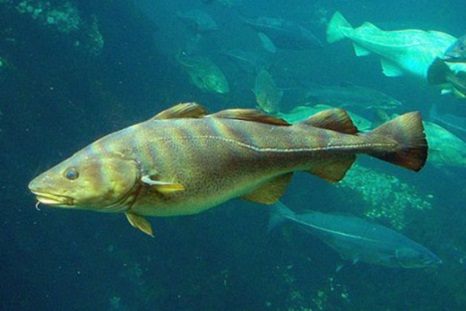
Ocean Industrialization: Fishing regulators fear wind turbines could threaten spawning area for Atlantic cod
It is the largest offshore HAPC designation in the region. Yet a main concern is cod spawning grounds in a smaller region within the designation, just east of Block Island. That area, known as Cox Ledge, overlaps with some 250 square miles currently leased to developers Ørsted and Eversource for their joint wind energy project: South Fork Wind. It is one of only two offshore wind projects that have completed the federal permitting process. “We are really going about the wind farm development very quickly,” said Kevin Stokesbury, a fisheries science professor at UMass Dartmouth, who studies cod in the Gulf of Maine. “It’s going to be quite a dramatic change to the ecosystem out there.” “We’ve all made sacrifices so cod can recover,” said Capt. Tim Rider, who fishes for groundfish and scallops. “Now they’re going to put a wind farm there,” he said of the cod spawning grounds. “How about they put it somewhere that might not be as intrusive.” >click to read< 11:05

SouthCoast Man of the Year: Kevin Stokesbury continues to seek solutions to fishing industry challenges
It’s pretty well known around these parts that homegrown research proved the ocean held more Atlantic sea scallops than federal regulators thought. And a lot of folks know that the value of those succulent bivalves has made New Bedford the highest-grossing fishing port in America for 18 years running. Starting in the late 1990s, Professor Kevin Stokesbury of the School for Marine Science and Technology at UMass Dartmouth, working with SMAST founding dean Brian Rothschild, developed a video technique to count scallops on the seafloor without harvesting or killing them. Along the way, he pioneered a partnership with local fishermen. >click to read<11:20

Lifting all boats: 2018 honorees fight for the future of the New Bedford fishing industry
The year 2018 was like none other for the New Bedford fishing industry. The groundfish industry, already reeling from several decades of species collapse and arduous federal regulations, suffered a crippling setback with the National Oceanic and Atmospheric Administration’s ban on fishing in Sector 7. The Standard-Times and SouthCoastToday this year are proud to name Cassie Canastra and Kevin Stokesbury as the SouthCoast Woman and Man of the Year for what they have done for the industry that year after year makes New Bedford the Number 1 dollar fishing port in the nation. >click to read<23:12
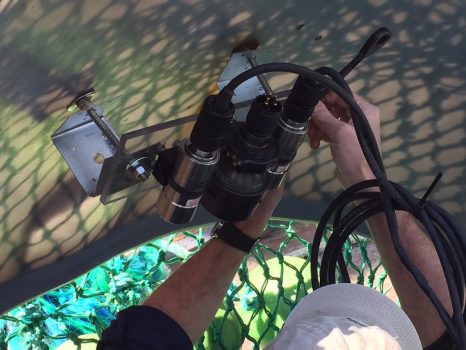
Live Cam May Show True Status of Atlantic Cod Fishery
Atlantic cod, New England’s most iconic fish, has been reported at historic lows for years, but fishermen hope a new video monitoring technique will prove there are more of the fish than federal surveyors believe. Ronnie Borjeson, who has been fishing for more than 40 years, says the federal surveys don’t match up with what fishermen are seeing. “I don’t care if you’re a gillnetter, a hook and line guy, a trawl guy,” he said, “there’s codfish everywhere up there. Everywhere. You can’t get away from them.” Borjeson helped test a video rig designed by researchers at the University of Massachusetts Dartmouth that allows them to record fish underwater and count them on the video later. With this rig, scientists can sample a larger area in the same amount of time and hopefully improve federal estimates of how many cod are left. click here to read the story 16:26
Counting Fish – A film by Don Cuddy click here to watch
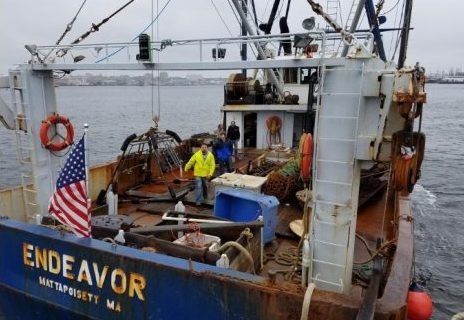
Don Cuddy: Stokesbury’s science continues to yield scallops for SouthCoast
It’s been a long and busy summer for Kevin Stokesbury and his team of scallop researchers at UMass Dartmouth’s School for Marine Science and Technology. But a lot of sea time, following many months of preparation, has paid off in a big way. “We surveyed the entire footprint of the scallop resource from Virginia all the way up to the Hague Line,” Kevin told me. “That’s 70,000 kilometers square, a huge area. We’re all really jazzed.” The data was gathered using the system developed by Kevin in the 90′s, dropping underwater cameras mounted on a steel pyramid to the sea bed from the deck of a commercial scalloper. The work began at the end of April and finished in mid-July. click here to read the story 19:27
UMass Dartmouth awarded $1M for scallop, flounder fisheries research
 University of Massachusetts Dartmouth scientists will receive $1 million in federal research funds to improve management of the scallop and flounder fisheries.The funding, from the National Oceanic and Atmospheric Administration Northeast Fisheries Science Center and New England Fishery Management Council Sea Scallop Research Set-Aside Program, was awarded last week to the researchers at the UMass School for Marine Science and Technology.Projects will focus on bycatch reduction, scallop biomass and improving the understanding of scallop biology. The scallop survey research will be led by Kevin Stokesbury, while Daniel Georgiana will expand on previous sea scallop gray-meat research. Link 11:51
University of Massachusetts Dartmouth scientists will receive $1 million in federal research funds to improve management of the scallop and flounder fisheries.The funding, from the National Oceanic and Atmospheric Administration Northeast Fisheries Science Center and New England Fishery Management Council Sea Scallop Research Set-Aside Program, was awarded last week to the researchers at the UMass School for Marine Science and Technology.Projects will focus on bycatch reduction, scallop biomass and improving the understanding of scallop biology. The scallop survey research will be led by Kevin Stokesbury, while Daniel Georgiana will expand on previous sea scallop gray-meat research. Link 11:51
2017-2018 Sea Scallop Research Set-Aside Recommended Awards Announced – Click here to read about the projects
New Bedford again tops nation for dollar value of fishing catch
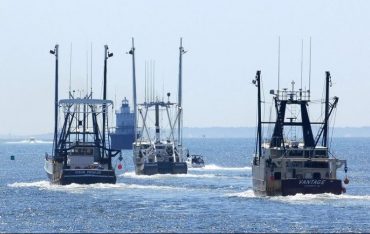 The city’s port has again topped the country for dollar value of its fishing catch, NMFS reported this week, citing 2015 landings worth $322 million. That marks 16 years in a row that New Bedford has held the top-value title, which is thanks largely to scallops. Dutch Harbor, Alaska, again was tops for total volume of catch, landing 787 million pounds last year. “The scallop industry has put New Bedford at the top of the food chain, as it were, of fishing ports for the last 16 years — that’s a very impressive streak,” said Ed Anthes-Washburn, port director for the city’s Harbor Development Commission. “It really shows the impact of scallops but also the impact of cooperative research.” In the 1990s, SMAST scientists Brian Rothschild and Kevin Stokesbury pioneered innovations in counting scallops, with cameras tested and used on local scallopers. The resulting data affected stock assessments by the National Oceanic and Atmospheric Administration (NOAA), ultimately leading to larger catch quotas and helping secure steady catches for waterfront businesses. Read the rest here 19:52
The city’s port has again topped the country for dollar value of its fishing catch, NMFS reported this week, citing 2015 landings worth $322 million. That marks 16 years in a row that New Bedford has held the top-value title, which is thanks largely to scallops. Dutch Harbor, Alaska, again was tops for total volume of catch, landing 787 million pounds last year. “The scallop industry has put New Bedford at the top of the food chain, as it were, of fishing ports for the last 16 years — that’s a very impressive streak,” said Ed Anthes-Washburn, port director for the city’s Harbor Development Commission. “It really shows the impact of scallops but also the impact of cooperative research.” In the 1990s, SMAST scientists Brian Rothschild and Kevin Stokesbury pioneered innovations in counting scallops, with cameras tested and used on local scallopers. The resulting data affected stock assessments by the National Oceanic and Atmospheric Administration (NOAA), ultimately leading to larger catch quotas and helping secure steady catches for waterfront businesses. Read the rest here 19:52

THIS IS OUTRAGEOUS! SMAST scallop researcher rejected for NOAA funding for first time since 1999
For the first time since 1999, internationally known SMAST scientist Kevin Stokesbury has been denied federally administered funding for annual scallop surveys, as government officials questioned the cost and design of his latest proposal. Many local fishermen credit Stokesbury’s work with reviving the scallop industry over more than a decade, and a prominent scalloper said Tuesday that it was hard to make sense of the funding denial this year. “We as an industry are very upset about this — it’s very disturbing,” said Dan Eilertsen, who owns six scallopers based on Fish Island. “Our fishery has been managed based on the published work that (Stokesbury) does.” The National Marine Fisheries Service, under the National Oceanic and Atmospheric Administration (NOAA), told Stokesbury on March 29 that his proposal for a $2.65 million scallop survey project had been denied for the 2016-17 grant cycle. Read the rest here 20:14
1 fish, 2 fish: Film examines new seafood counting technology
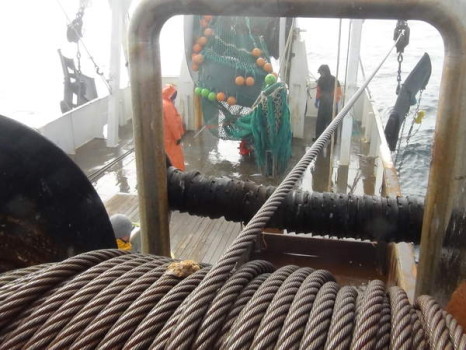 It appears to be an unanswerable question: “How many fish are in the ocean?” But marine research scientist Kevin Stokesbury is searching for that number, and his findings could have far reaching implications for fisherman facing catch limits. Part of Stokesbury’s efforts have been documented in “Counting Fish”, a film shot and produced by Mattapoisett’s Don Cuddy. In the 1990s, Stokesbury developed new video technology that brought big changes to the scallop industry. The methods showed that scallops were being undercounted with the old methods, drastically increasing catch limits for New Bedford fishermen. Read the rest here 08:01
It appears to be an unanswerable question: “How many fish are in the ocean?” But marine research scientist Kevin Stokesbury is searching for that number, and his findings could have far reaching implications for fisherman facing catch limits. Part of Stokesbury’s efforts have been documented in “Counting Fish”, a film shot and produced by Mattapoisett’s Don Cuddy. In the 1990s, Stokesbury developed new video technology that brought big changes to the scallop industry. The methods showed that scallops were being undercounted with the old methods, drastically increasing catch limits for New Bedford fishermen. Read the rest here 08:01
SMAST survey of groundfish has potential to improve regulation
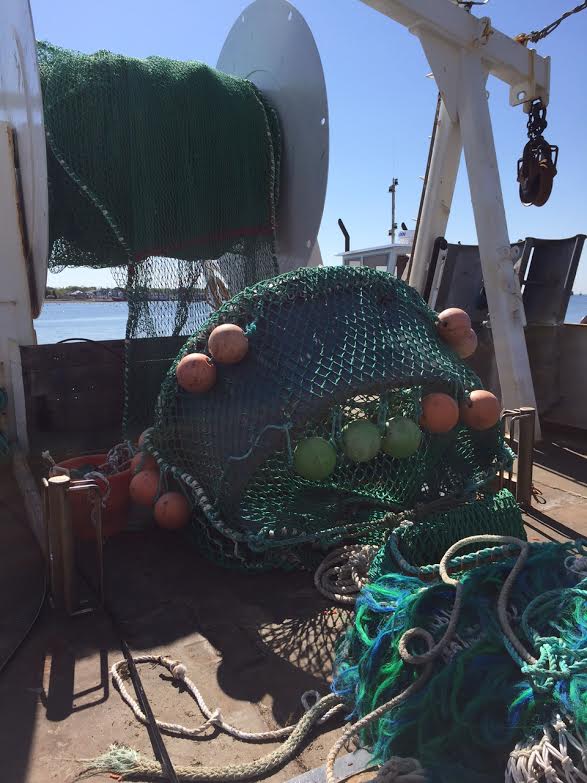 It was May 14, a Thursday. The big yellow Caterpillar roared to life beneath us, throbbing through the steel deck plates; a signal that it was time to cast off the surly bonds of earth. Capt. Ron Borjeson backed the Justice down. The Justice is a scallop boat, but as the net reel above the stern ramp proclaimed, we were rigged for groundfish. But this was to be no ordinary fishing trip. Kevin Stokesbury was heading a scientific expedition, targeting groundfish but trying to count rather than catch them. The flatfish net on the Justice was designed to enable fish to pass through the mouth and escape through the open end unharmed. Their passing would, however, be filmed by cameras mounted inside the net, with their number and species recorded on video and stored for later analysis. Read the rest here 22:52
It was May 14, a Thursday. The big yellow Caterpillar roared to life beneath us, throbbing through the steel deck plates; a signal that it was time to cast off the surly bonds of earth. Capt. Ron Borjeson backed the Justice down. The Justice is a scallop boat, but as the net reel above the stern ramp proclaimed, we were rigged for groundfish. But this was to be no ordinary fishing trip. Kevin Stokesbury was heading a scientific expedition, targeting groundfish but trying to count rather than catch them. The flatfish net on the Justice was designed to enable fish to pass through the mouth and escape through the open end unharmed. Their passing would, however, be filmed by cameras mounted inside the net, with their number and species recorded on video and stored for later analysis. Read the rest here 22:52
UMass Dartmouth plays integral part in booming scallop business
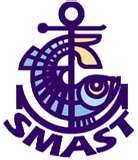 Our beloved scallop, the biggest and best in the world, is right off our coast, waiting to make our lives better. The scallop — or placopecten magellanicus — keeps New Bedford the most profitable fishing port in the United States. Those riches wash all over southeastern Massachusetts. Scallops grow on the sandy bottom of Georges Bank, a rise in the sea floor that runs from Maine to New Jersey. The bank starts 20 miles offshore and runs 200 miles out in the ocean. There was a moratorium on fishing for several species, including scallops, after stocks plummeted on Georges Bank in the late 1990s. By 2000, fishermen believed scallops had made a comeback, so they enlisted UMass Dartmouth for help. READ [email protected] 02:13
Our beloved scallop, the biggest and best in the world, is right off our coast, waiting to make our lives better. The scallop — or placopecten magellanicus — keeps New Bedford the most profitable fishing port in the United States. Those riches wash all over southeastern Massachusetts. Scallops grow on the sandy bottom of Georges Bank, a rise in the sea floor that runs from Maine to New Jersey. The bank starts 20 miles offshore and runs 200 miles out in the ocean. There was a moratorium on fishing for several species, including scallops, after stocks plummeted on Georges Bank in the late 1990s. By 2000, fishermen believed scallops had made a comeback, so they enlisted UMass Dartmouth for help. READ [email protected] 02:13






